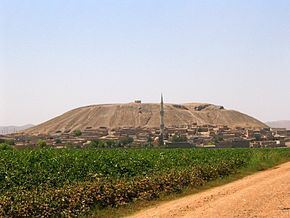Type Settlement Width 50 m (160 ft) Period Assyria | Length 100 m (330 ft) Area 0.5 ha (1.2 acres) | |
 | ||
Location Sultantepe Köyü, Şanlıurfa Province, Turkey | ||
The ancient temple-complex, perhaps of Huzirina, now represented by the tell of Sultantepe, is a Late Assyrian archeological site at the edge of the Neo-Assyrian empire, now in Şanlıurfa Province, Turkey. Sultantepe is about 15 kilometres (9.3 mi) south of Urfa on the road to Harran. The modern village of Sultantepe Köyü lies at the base of the tell.
Contents
History
Excavations have revealed an Assyrian city, with eighth to seventh century levels that were rebuilt after ca 648 BCE, containing a hoard of cuneiform tablets, including versions of the Epic of Gilgamesh and school texts including exercise tablets of literary compositions full of misspellings. The complete library of some 600 unfired clay tablets was found outside a priestly family house. Contracts also found at the site consistently record Aramaean names, J. J. Finkelstein has remarked The writings end suddenly simultaneously with the fall of nearby Harran in 610 BCE, two years after the fall of Nineveh. The tablets from Sultantepe now form the Assyrian library in the Archaeological Museum at Ankara. The site remained unoccupied during the subsequent Neo-Babylonian and Achaemenid periods, to be re-occupied by Hellenistic and Roman times. The modern village lies in an arc round the base of the mound on the north and east.
Archaeology
Sultantepe is a steep-sided mound over 50 m. high, with a flat top measuring 100 by 50 m.. Erosion on one side had exposed giant basalt column-bases, apparently belonging to a monumental gateway, which established the Assyrian level, at which, on another face of the mound, massive wall-ends projected, standing on the same level, some 7 m. below the top surface of the mound. The temple was eventually identified as dedicated to Sin by a well-carved stele bearing his symbol of a crescent moon with its horns upwards on a pedestal in relief.
A brief preliminary campaign at Sultantepe in May–June 1951 was followed by a series of soundings made in 1952 by Seton Lloyd of the British Institute or Archaeology at Ankara with Nuri Gökçe, of the Archaeological Museum, Ankara. Further work at the site was precluded by the seven-meter layer of Hellenistic and Roman era debris covering the remainder of the site.
The Sultantepe Tablets
A series of publications of The Sultantepe Tablets have been edited and published in Anatolian Studies (British Institute at Ankara) from 1953 onwards by O. R. Gurney and others. The texts range widely. Some of the highlights are:
Other texts of importance include rituals, incantations, omen readings, contracts and vocabulary lists.
